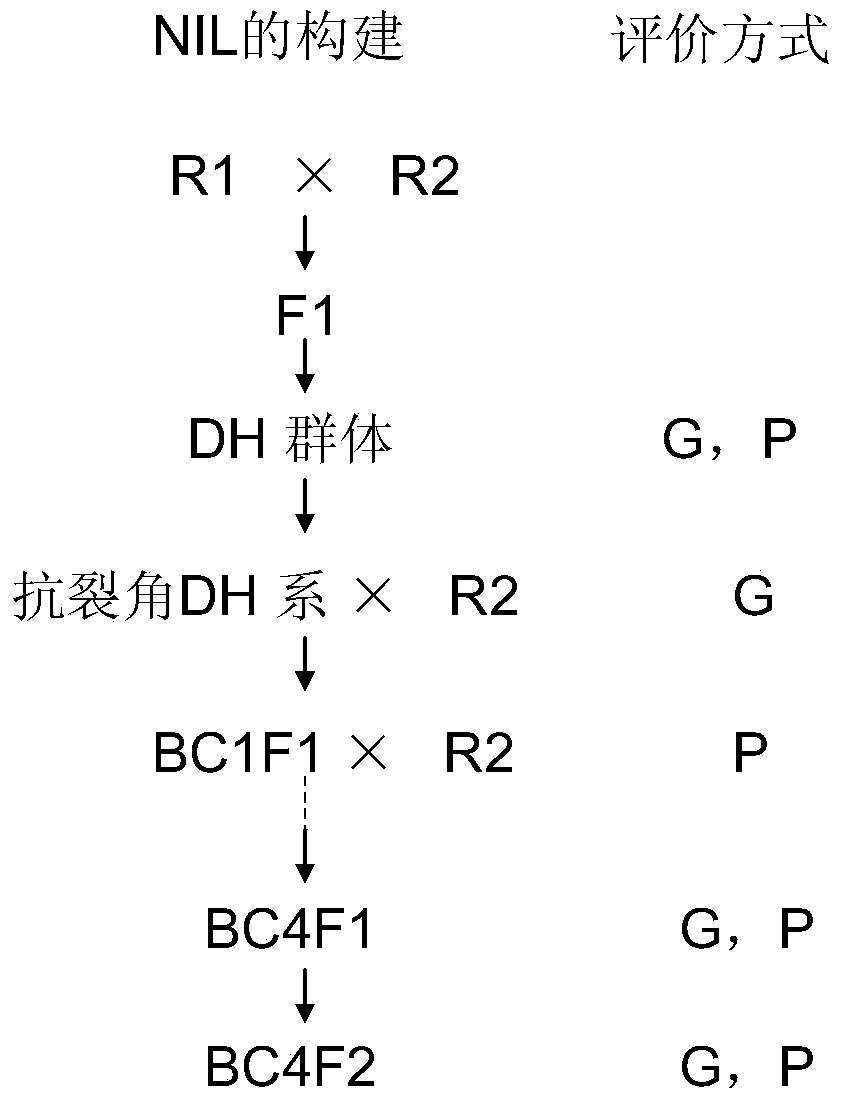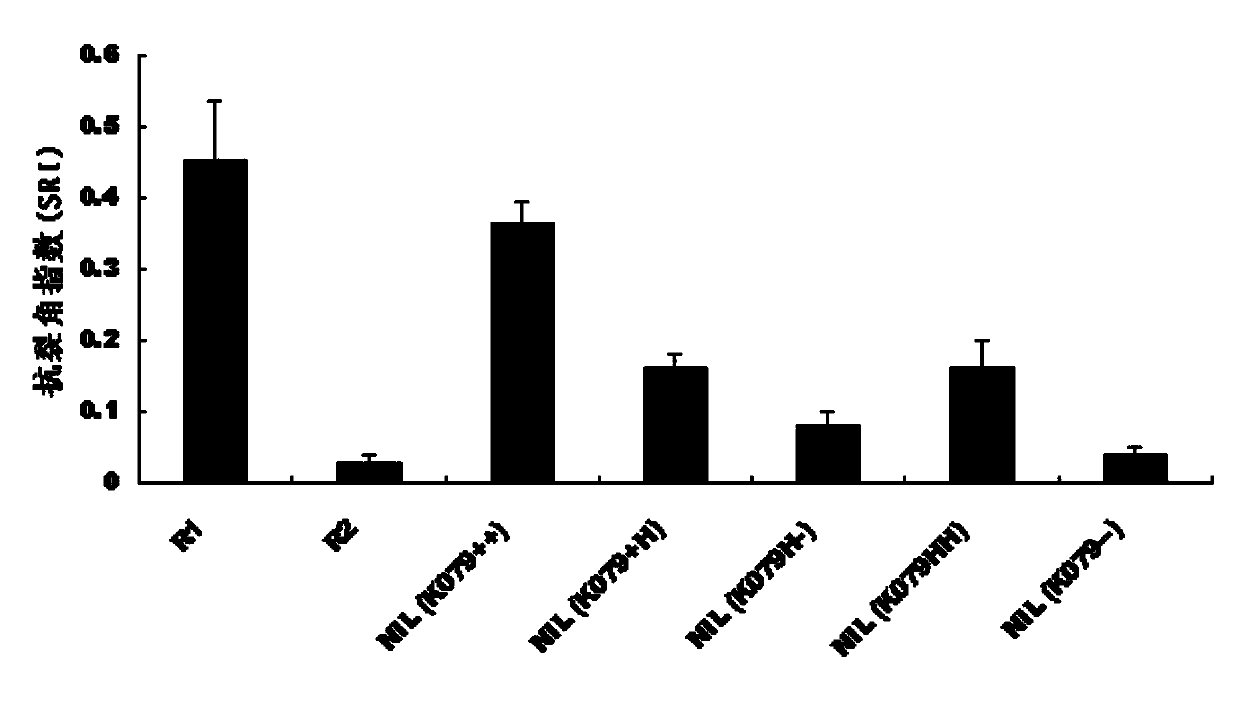Molecular markers related to the main effect QTL of anti-cracking angle trait in rapeseed and its application
A molecular marker, anti-cracking angle technology, applied in the determination/inspection of microorganisms, biochemical equipment and methods, DNA / RNA fragments, etc. , to achieve the effect of speeding up the breeding process, clear location, convenient and fast detection method
- Summary
- Abstract
- Description
- Claims
- Application Information
AI Technical Summary
Problems solved by technology
Method used
Image
Examples
Embodiment 1
[0032] Discovery of main effect QTL (qSRI.2) for anti-cracking angle
[0033] (1) Field experiment and phenotypic determination of anti-cracking angle index:
[0034]Field experiments were carried out at the Yangluo Experimental Station of the Chinese Academy of Agricultural Sciences Oil Plant Research Institute (Wuhan) from 2011 to the autumn of 2015, and at Qinghai University (Xining, Qinghai) from the summer of 2011 to 2015, and autumn sowing was carried out in Wuhan in mid-September every year. Harvest in early May of the following year, summer sowing in Qinghai in mid-May, and harvest in September. The sowing plot is flat and fertile, and the base fertilizer is evenly applied. The row length is 210cm, the plant spacing is 15cm, and the row spacing is 33cm. Cracking resistance index (SRI) of strains or single plants at maturity stage, identification method references (Peng Pengfei, Li Yunchang, Mei Desheng, Liu Daomin, Fu Li, Wang Hui, Sang Shifei, Chen Yufeng, Hu Qiong. ...
Embodiment 2
[0047] Application of a molecular marker primer related to the major QTL of anti-cracking angle trait in rapeseed in high-yield breeding:
[0048] 1. The experimental materials are as follows:
[0049] Two parental materials used for initial mapping: R1 and R2, DH population and BC4F2 single plant for further fine mapping.
[0050] 2. Primers for genotype detection:
[0051] BnS1: AGCTA AGAGC TGAAG CACGG; AGATG CTGAA ATTCG TCTGT GA.
[0052] BnS2: TCAAC TTGAC ATGTT CACTA ATAGT TT; CAATA GACAC GGAAA TGGGC.
[0053] 3. Genotype detection method
[0054] When 5 leaves were left, leaf DNA was extracted, and the working solution diluted to a concentration of 10 ng / μl was used for PCR amplification, and the obtained PCR products were detected by capillary electrophoresis. The amplification system and procedure of BnS1 and BnS2:
[0055] The PCR amplification system is: 2×Taq Mix 5ul, forward primer (10uM / ul) 1μl, reverse primer (10uM / ul) 1μl, gDNA 1μl, ddH2O 2μl, Total 10μl. B...
Embodiment 3
[0062] Example 3: Universality of BnS1 and BnS2 primer pairs:
[0063] 1. The experimental materials are as follows:
[0064] 35 rapeseed materials with anti-cracking angle coefficients ranging from 0.02 to 0.49 were selected, as shown in Table 3.
[0065] 2. Genotype detection method
[0066] When 5 leaves were left, leaf DNA was extracted, and the working solution diluted to a concentration of 10 ng / μl was used for PCR amplification, and the obtained PCR products were detected by capillary electrophoresis. The amplification system and procedure of BnS1 and BnS2:
[0067] The PCR amplification system is: 2×Taq Mix 5ul, forward primer (10uM / ul) 1μl, reverse primer (10uM / ul) 1μl, gDNA 1μl, ddH2O 2μl, Total 10μl. BnS1 is a red fluorescent primer, and BnS2 is a blue fluorescent primer.
[0068] PCR reaction conditions: 94°C, 3min; 94°C, 30s; 58°C, 30s, 72°C, 45s; 35 cycles; 72°C, 10min; 4°C, till use.
[0069] Capillary electrophoresis on the machine, the machine model is AB...
PUM
 Login to View More
Login to View More Abstract
Description
Claims
Application Information
 Login to View More
Login to View More - R&D
- Intellectual Property
- Life Sciences
- Materials
- Tech Scout
- Unparalleled Data Quality
- Higher Quality Content
- 60% Fewer Hallucinations
Browse by: Latest US Patents, China's latest patents, Technical Efficacy Thesaurus, Application Domain, Technology Topic, Popular Technical Reports.
© 2025 PatSnap. All rights reserved.Legal|Privacy policy|Modern Slavery Act Transparency Statement|Sitemap|About US| Contact US: help@patsnap.com



